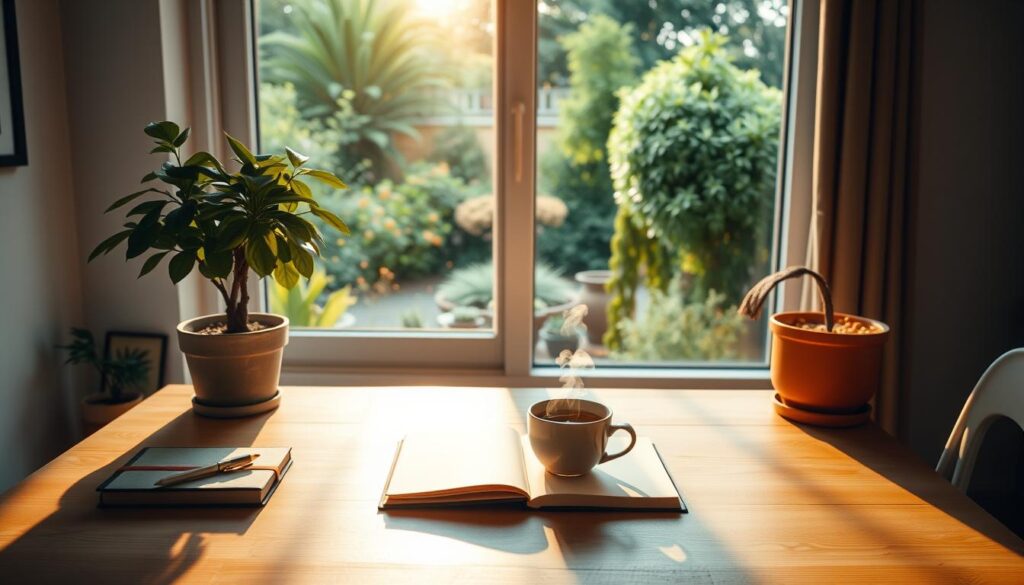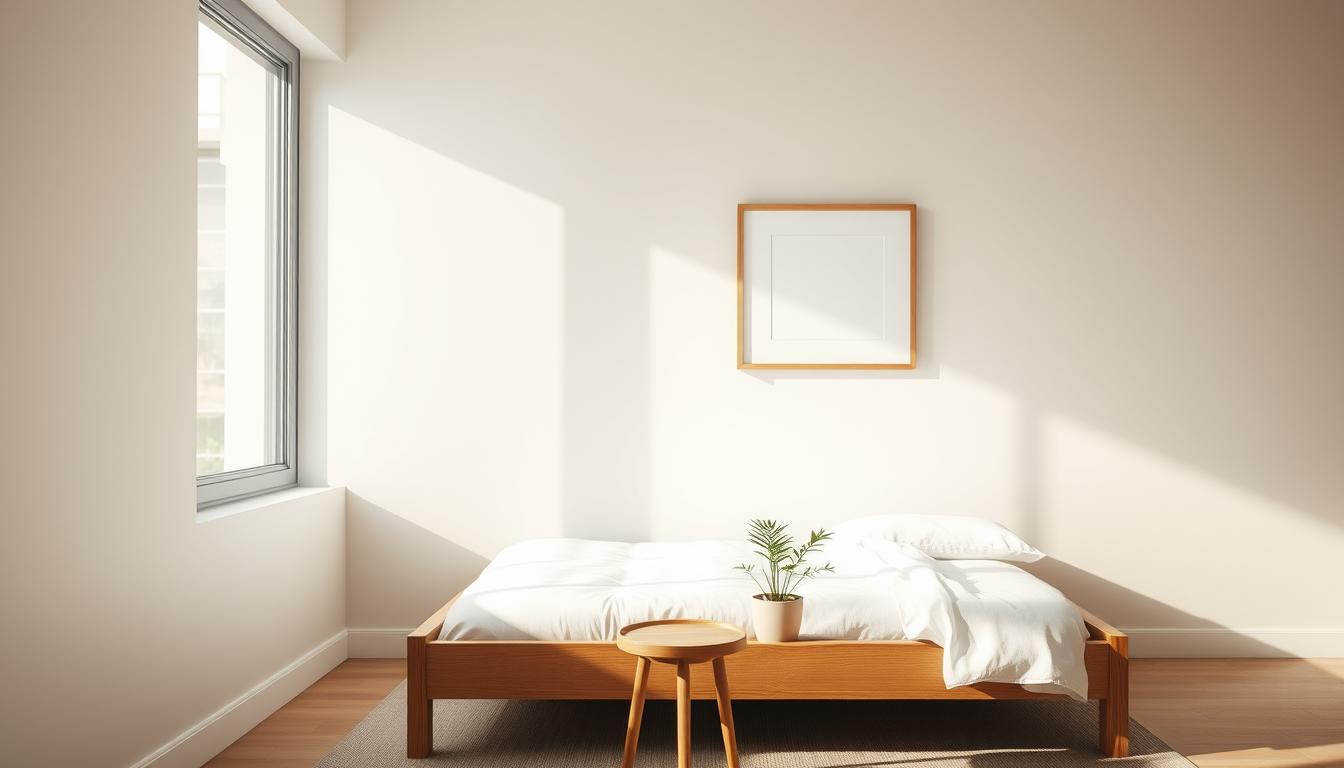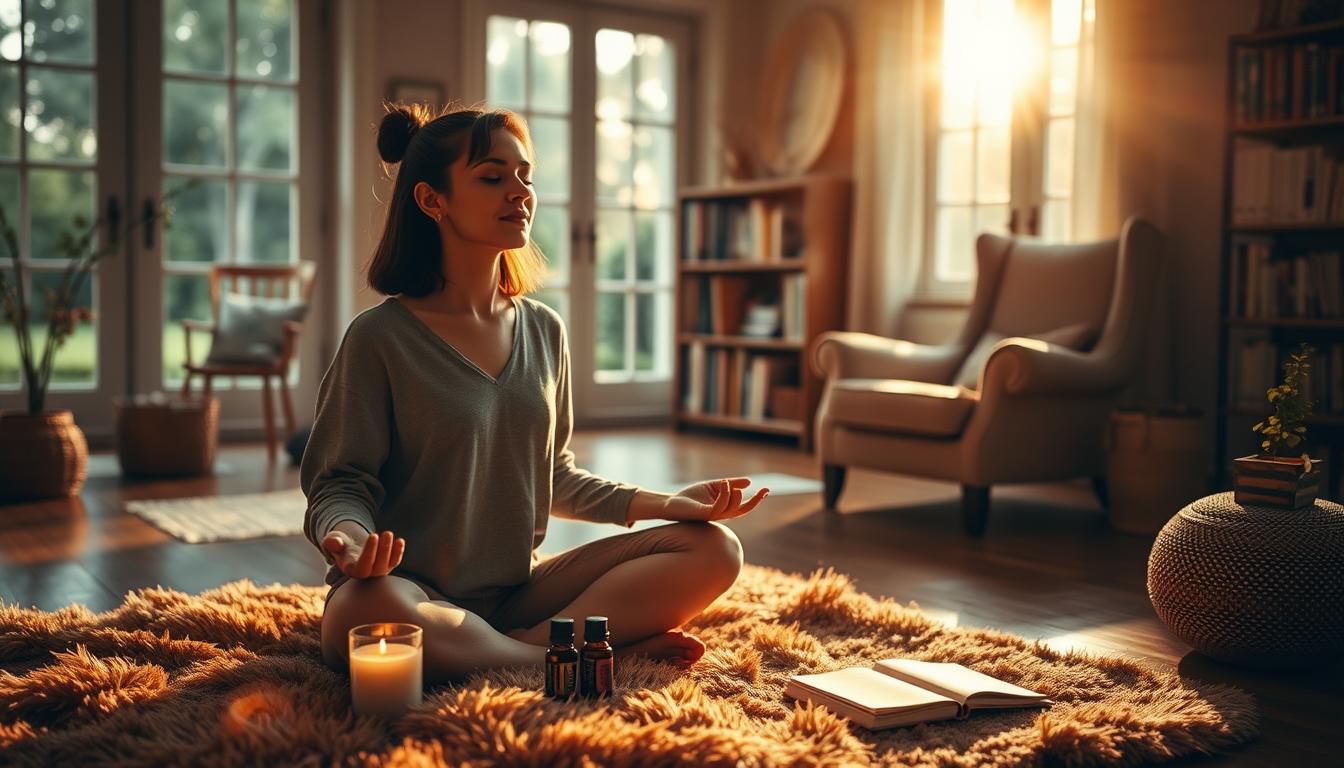“The ability to simplify means to eliminate the unnecessary so that the necessary may speak.” – Hans Hofmann
Modern life can be overwhelming. It’s filled with chaos and clutter. Simplifying our lives is more than just cleaning up our space. It’s about cultivating a mindset that values clarity and purpose.
By adopting a minimalist approach, we can let go of distractions. This lets us live intentionally. It’s not about giving up things we love. It’s about making room for what truly matters.
Key Takeaways
- Simplifying your life can lead to a more purposeful existence.
- Adopting a minimalist lifestyle helps in eliminating unnecessary clutter.
- Cultivating a clear and focused mind is essential for intentional living.
- Embracing minimalism is a journey towards a more mindful life.
- Letting go of distractions allows for a more intentional lifestyle.
Understanding Intentional Living
Intentional living means making every choice with a clear purpose. It’s about living deliberately, making choices that reflect your values. This way of life is both meaningful and fulfilling.
What is Intentional Living?
Intentional living focuses on mindfulness and purpose. It’s about being true to yourself, making choices that enhance your well-being. This lifestyle encourages you to be present and appreciate the simple things.
By choosing intentional living, you’re not just changing habits. You’re changing how you view life. You become more aware of your thoughts and actions. You make choices that align with your long-term goals and values.
The Benefits of Living with Intention
Living intentionally brings many benefits, like a clearer sense of purpose. You focus on what’s truly important. You avoid distractions that can slow you down.
- Increased mindfulness: Being more present and aware in your daily life.
- Improved well-being: Making choices that support your physical, emotional, and mental health.
- Greater fulfillment: Living a life that is true to your values and aspirations.
Embracing intentional living is a big step towards a more purposeful and fulfilling life. It’s a journey that needs commitment, patience, and self-awareness. But the rewards are worth the effort.
The Minimalist Mindset
Exploring minimalism shows its deep impact on our daily lives. At its heart, minimalism is about simplicity and purpose. It’s a way of life that helps us remove the unnecessary and focus on what truly adds value.
Minimalism isn’t just about cleaning up our physical space. It’s also about adopting a mindset that values simplicity and clarity. By embracing minimalism, we can live more intentionally and focus better.
Defining Minimalism
Many people think minimalism means living with less, but it’s not about deprivation. Minimalism is about being intentional with our resources, time, and energy. It’s about making room for what truly matters by letting go of the excess.
“Minimalism is not a lack of something, but the right amount of something.” – Joshua Fields Millburn
Minimalism in Daily Life
So, how do we apply minimalism in our daily lives? Here are some intentional living practices to get you started:
- Simplify your wardrobe by keeping only what you wear regularly.
- Streamline your digital life by unsubscribing from unnecessary emails and notifications.
- Practice mindful consumption by buying only what you need.
By adding these practices to our daily routine, we can live a more minimalist lifestyle that supports our well-being.
How Minimalism Influences Intentional Living
Minimalism greatly impacts our ability to live intentionally. By cutting down on clutter and distractions, we can better focus on our goals and values. Here are some intentional living tips that show how minimalism and intentional living are connected:
| Minimalist Principle | Intentional Living Benefit |
|---|---|
| Simplification | Reduces stress and mental clutter |
| Mindful Consumption | Encourages thoughtful decision-making |
| Clarity | Enhances focus on personal goals |
Adopting a minimalist mindset makes us more intentional in our daily choices. This leads to a more purposeful and fulfilling life.

Steps to Declutter Your Mind
Getting a clutter-free mind is the first step to a more intentional life. Our minds collect unnecessary thoughts and worries daily. By decluttering our minds, we can focus better and live more purposefully.
Identify Mental Clutter
The first step is to notice the mental clutter holding you back. This can be negative thoughts, anxiety, or trouble focusing. Reflect on your thoughts and feelings to spot patterns or worries.
Think about where these thoughts come from. Are they from past experiences, future fears, or today’s worries? Knowing this can help you tackle the root causes.
Effective Decluttering Techniques
After spotting mental clutter, try effective ways to clear it. Mindfulness meditation is a great tool. It helps you stay present and calm your mind.
Journaling is another helpful method. It lets you write down your thoughts and feelings. This can help you understand and tackle your mental clutter. Also, make time for reflection and self-care to keep your mind clear.
“The mind is everything; what you think, you become.” – Buddha
Remember, decluttering your mind is an ongoing journey. Be patient and don’t hesitate to ask for help when you need it. By sticking to these strategies, you can enjoy the benefits of intentional living and live a more fulfilling life.
The Role of Mindfulness in Intentional Living
Intentional living and mindfulness go hand in hand. They help us live more aware and present. By adding mindfulness to our daily lives, we gain clarity and purpose.

Practicing Mindfulness Daily
To start, set aside a few minutes each day for mindfulness meditation. It can be as simple as focusing on your breath or noticing your body’s sensations. Mindfulness is about being present in the moment.
Another way to practice mindfulness is to do it during daily activities. For instance, eat mindfully by savoring each bite. Or, walk mindfully by paying attention to your feet and breath.
Mindfulness Exercises to Try
Here are some mindfulness exercises to try for intentional living:
- Body Scan Meditation: Lie down or sit comfortably. Focus on each part of your body, starting from your toes. Notice any sensations or feelings.
- Mindful Breathing: Focus on your breath. Observe its pattern and the air moving in and out of your nostrils. If your mind wanders, gently bring it back to your breath.
- Walking Meditation: Pay attention to your walking. Notice your feet touching the ground, your legs moving, and your breath’s rhythm.
By adding these mindfulness exercises to your daily routine, you’ll become more aware and clear. This leads to a more intentional and fulfilling life.
Simplifying Your Space for Clarity
By making your space simpler, you can create a place that helps you stay focused and live more intentionally. This starts with realizing how your surroundings affect your mind.
A messy and disorganized home can make you feel overwhelmed and anxious. It’s hard to live purposefully in such a space. But, a tidy and organized home can bring calm and clear thinking.
Decluttering Your Living Environment
Decluttering is the first step to simplify your space. It means getting rid of things that clutter your space and distract you. Here’s how to start decluttering:
- Find areas in your home or workspace that feel too cluttered or overwhelming.
- Sort items into categories (like keep, donate, sell, or discard) to help decide what to do with them.
- Start with small areas or tasks to build momentum and make it less overwhelming.
When decluttering, remember it’s not just about getting rid of stuff. It’s about creating a space that supports your intentional lifestyle. Keep items that make you happy or serve a purpose, and let go of the rest.
The Impact of a Clean Space on Mental Health
A clean and organized space can greatly improve your mental health. As
“Clutter is not just the stuff on your floor — it’s anything that stands between you and the life you want to be living.”
Keeping your environment tidy can reduce stress, improve focus, and boost your overall well-being.
By keeping your living space simple and organized, you can live more mindfully and intentionally. This supports your journey towards a more purposeful life.
Creating Your Business and Personal Goals
Creating a fulfilling life means setting goals that match our values and dreams. It’s key to have a clear direction in both our personal and work lives as we aim for intentional living.

Setting Intentional Goals
Setting goals is more than just success; it’s about living a life that shows what we truly value. First, we need to figure out what’s most important to us. This means thinking about our core values, passions, and future dreams. Knowing what drives us helps us set goals that are both meaningful and exciting.
It’s important to think about both our personal and work goals. This balanced approach helps our goals support our overall happiness. For example, if we want to advance in our career, we should also think about how it affects our personal life and vice versa.
The SMART Goal Framework
The SMART goal framework is a great way to set goals. SMART means Specific, Measurable, Achievable, Relevant, and Time-bound. This method helps make our goals clear and reachable.
- Specific: Clearly define what you want to achieve.
- Measurable: Quantify your goal so you can track progress.
- Achievable: Ensure your goal is realistic based on your resources and constraints.
- Relevant: Align your goal with your values and long-term objectives.
- Time-bound: Set a specific deadline for achieving your goal.
Using the SMART framework helps us set goals that are inspiring and doable. This method keeps us focused and motivated, leading to a more intentional and fulfilling life.
Building Healthy Habits
Creating a life of intention is more than just thinking differently. It requires consistent, healthy habits. We need to build routines and practices that support our goals and well-being.
Daily Routines that Foster Intentional Living
Daily routines are essential for intentional living. By adding simple, consistent practices to our daily lives, we can live more intentionally. For instance, starting the day with mindfulness or a short exercise routine can help us stay focused.
Some effective daily routines include:
- Morning meditation to clear your mind and set intentions
- Gratitude journaling to cultivate a positive mindset
- A consistent sleep schedule to improve rest and recovery
Adopting these routines can bring intentional living benefits like less stress and more productivity.
The Importance of Consistency
Consistency is vital for building healthy habits. It’s not about being perfect; it’s about showing up every day, even when it’s hard. By sticking to our routines and practices, we build resilience and move closer to our goals.
| Habit | Frequency | Benefit |
|---|---|---|
| Meditation | Daily | Reduces stress and anxiety |
| Exercise | 3-4 times a week | Improves physical and mental health |
| Gratitude journaling | Daily | Cultivates a positive mindset |
Understanding the value of consistency and adding daily routines that support intentional living helps us build intentional living habits. These habits lead to a more purposeful and fulfilling life.
Overcoming Obstacles to Intentional Living
Living intentionally is a journey filled with challenges. It’s not just about starting strong. It takes ongoing effort and staying strong.

Common Challenges People Face
Many people struggle when they try to live more intentionally. They face:
- Internal Resistance: Our minds don’t like change, making new habits hard.
- External Pressures: What others think and do can pull us off track.
- Lack of Clarity: Without clear goals, it’s easy to lose direction.
Strategies to Stay Committed
To beat these challenges, there are ways to stay on track. Keeping your intentional living motivation alive is key.
- Set Clear Goals: Know what intentional living means to you and set goals you can reach.
- Build a Supportive Environment: Be around people who support and cheer you on.
- Practice Self-Compassion: Be kind to yourself when you slip up. It’s all part of the journey.
By knowing the obstacles and using these strategies, you can keep moving forward. Remember, the journey itself is valuable, not just the end goal.
The Power of Gratitude
Gratitude can change how we see the world, making our lives more fulfilling. As we live more intentionally, being thankful is key.
Practicing Gratitude for Intentional Living
To add gratitude to our daily routine, start a gratitude journal. Write down three things you’re thankful for each day. This can really change how you see the good in your life.
Also, telling others you’re thankful can make your relationships stronger. It helps build a sense of community too.
How Gratitude Changes Your Perspective
Gratitude helps us live in the moment. When we focus on what we’re thankful for, we start to see the little joys in life. This makes our lives more mindful and purposeful.
Adding gratitude to our daily life makes us more optimistic. This optimism helps us face challenges better and feel more fulfilled.
Remember, gratitude grows stronger with practice. By making it a habit, we can enjoy its many benefits.
Community and Support
Starting your intentional living journey can be easier with a supportive community. Being around people who share your values and goals can give you motivation and a sense of belonging.
Finding Like-Minded Individuals
Finding others on a similar path can be very rewarding. Here are a few ways to meet like-minded people:
- Join online forums and social media groups focused on intentional living
- Attend local workshops and events related to minimalism and mindfulness
- Participate in community activities that align with your values
Connecting with others who share your passion for intentional living can create a supportive network. This network helps you stay focused on your goals.
The Role of Support Groups
Support groups are key in building a sense of community and connection. They offer a safe space to share experiences and challenges.
Joining a support group can bring many benefits, including:
| Benefit | Description |
|---|---|
| Accountability | Regular check-ins help you stay on track with your goals |
| Shared Knowledge | Members share tips and strategies for overcoming common challenges |
| Emotional Support | A supportive community provides encouragement and understanding |
Being part of a support group can give you valuable insights and keep you motivated on your intentional living journey.

Living an intentional lifestyle is more than personal choices. It’s about being part of a community that supports and uplifts you. Remember, you’re not alone on this journey. There are others walking with you, sharing in the joys and challenges.
Measuring Your Progress
As you keep moving forward on your intentional living path, it’s key to look back and see how far you’ve come. This helps you stay on track and reach your goals. You’ll also know where you need to work harder and where you’ve done well.
Reflecting on Progress
Make time to write down your thoughts, feelings, and experiences. This helps you understand your emotions and see how you’ve grown. You might want to use a journal like “The Five Minute Journal” to track your daily thoughts and see how you’ve changed over time.
Tools for Continued Growth
Along with journaling, think about using planners and mindfulness tools to help you stay on track. Items like the “Passion Planner” and the “Mindfulness Exercises for Beginners” meditation kit can be found on Amazon. They help you stay focused and committed to your goals. Using these tools daily will help you handle challenges better and enjoy the benefits of intentional living, like less stress and clearer thinking.
By reflecting, planning, and practicing mindfulness, you can measure your progress. This way, you’ll keep growing and living more intentionally and purposefully. You’ll also learn more valuable intentional living tips along the way.
FAQ
What is intentional living, and how can it improve my life?
Intentional living means making choices to live more mindfully. It helps simplify your life, reduce stress, and increase happiness. By doing so, you can find more purpose and clarity in your daily life.
How do I start decluttering my mind and simplifying my life?
First, identify what clutters your mind, like negative thoughts or distractions. Then, find ways to deal with them. Mindfulness, meditation, or journaling can help clear your mind and live more intentionally.
What are some effective techniques for decluttering my living space?
Start by sorting items into keep, donate, or discard piles. Choose items that bring you joy or serve a purpose. Use a “one in, one out” rule to keep your space tidy and prevent clutter.
How can I stay committed to my intentional living goals?
Set clear, achievable goals and track your progress. Connecting with others who share your values can also help. Joining a community or finding like-minded friends can keep you motivated.
What role does mindfulness play in intentional living?
Mindfulness helps you live more intentionally. It makes you more aware of your thoughts, feelings, and actions. This awareness helps you make choices that align with your values and goals.
How can I incorporate gratitude practices into my daily routine?
Keep a gratitude journal by writing down three things you’re thankful for each day. Sharing your gratitude with someone or reflecting on it before bed can also be beneficial.
What are some recommended tools for tracking my progress on my intentional living journey?
Use a planner, journal, or mindfulness app to track your progress. There are many products on amazon.com that can support your journey, like guided journals and mindfulness tools.
How can I find like-minded individuals who share my commitment to intentional living?
Look for online communities or forums focused on intentional living. Attend local events and workshops that match your interests. Connecting with friends or family who share your values can also be helpful.
What are some common challenges people face when adopting intentional living practices, and how can I overcome them?
Challenges include staying motivated, dealing with distractions, and maintaining consistency. To overcome these, set clear goals, find support, and be patient with yourself. Cultivating new habits and mindsets takes time.














